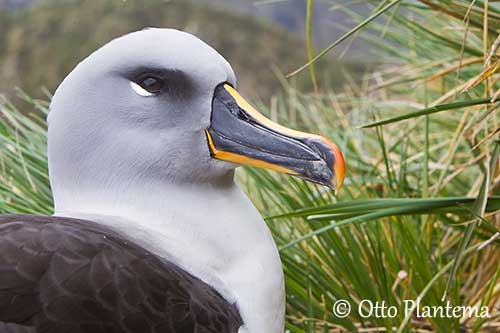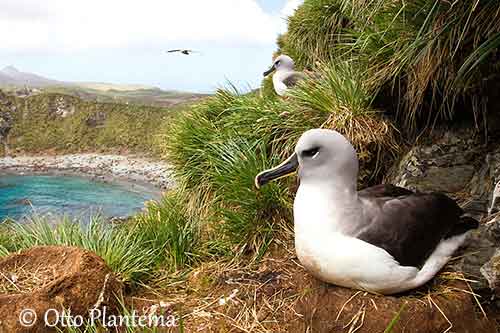
Fr: Albatros à tete grise
All: Graukopfalbatros
Esp: Albatros Cabecigrís
Ita: Albatro testagrigia
Nd: Grijskopalbatros
Sd: Gråhuvad albatross
Photographer:
Otto Plantema
Trips around the world
Text by Nicole Bouglouan
Sources:
HANDBOOK OF THE BIRDS OF THE WORLD vol 1 by Josep del Hoyo-Andrew Elliot-Jordi Sargatal - Lynx Edicions - ISBN: 8487334105
A Complete Guide to Antarctic Wildlife by Hadoram Shirihai and Illustrated by Brett Jarrett - Edited by Guy M. Kirwan - ALUL.A Press Oy, Finland - ISBN 9519894705
BirdLife International (BirdLife International)
Department of Sustainability, Environment, Water, Population and Communities
Australian Antarctic Division: Leading Australia's Antarctic Program
Grey-headed Albatross
Thalassarche chrysostoma
Procellariiformes Order – Diomedeidae Family
INTRODUCTION:
The Grey-headed Albatross breeds on several sub Antarctic islands, with the main populations on South Georgia, Campbell and Macquarie Islands. This species is threatened by long-lines fishing which kills a significant proportion of populations.
The breeding adults are known for their long-distance flights in search of food for their chicks. The maximum foraging ranges have been recorded to be 500-800/1850 km from their nest. They are graceful and powerful fliers.
DESCRIPTION OF THE BIRD:
Biometrics:
Length: 81 cm
Wingspan: 180-220 cm
Weight: 3000-3750 g
The adult has wholly grey head, neck and mantle. On the upperparts, back, scapulars and upperwing are darker, mostly blackish-brown. Outer primaries show white shafts. The tail is grey.
On the underparts, the underwing is white. The blackish margins are broader than most of Diomedeidae, with the broadest part on the basal third of the leading edge. Breast, belly, vent and undertail-coverts are white.

On the grey head, forehead and forecrown are paler grey, usually fading whiter on throat and foreneck. The neck is often paler grey, turning dark brownish-grey over the mantle.
Lores are blackish and there is a white crescent behind the eye.
The bill is black, with yellow upper and lower ridges, fading to orange-red at tip of upper mandible. The gape line is yellow. The eyes are dark brown to blackish. Legs and webbed feet are pale bluish-grey with pinkish webs.

Both sexes are similar.
The juvenile has mostly black bill and head, with the nape darker than in adults. The white crescents are less conspicuous. It may have whitish areas on crown and face.
The juvenile may spend up to 11 years at sea before returning to its natal island.
RANGE:
The Grey-headed Albatross has circumpolar distribution in the Southern Hemisphere. It breeds on sub Antarctic islands in South Georgia, Chilean offshore islands, Iles Kerguelen, Iles Crozet, Marion Island, Prince Edward Island, Campbell Island and Macquarie Island.
HABITAT:
The Grey-headed Albatross is marine and pelagic. It can be seen on land only during the breeding season. This species breeds on steep slopes or cliffs and among tussock grass, on remote oceanic islands.
Outside the breeding season, it remains at sea, and usually frequents much colder surface waters than other albatrosses.
CALLS AND SONGS:
The Grey-headed Albatross is usually silent at sea, but it may produce croaking, shrieking and gargling sounds when feeding in flocks, especially while following fishing ships.
The displays on land are accompanied by throaty calls, groans, grunts and moans. We can also hear the typical rattling sound produced by rapid and repeated bill-clapping used during courtship, but also as threatening sounds towards intruders.
BEHAVIOUR IN THE WILD:
The Grey-headed Albatross feeds on fish, squid, crustaceans, lampreys (Geotria australis) and carrion.
Preys are mostly taken by surface-seizing, but from some observations, it can also dive at least to six metres below the surface, and swim underwater for about ten seconds while searching for preys.
This species forages mainly away from the continental shelf, and feeds far from the shelf waters around islands and continents. It also forages behind fishing boats.

They are monogamous and pair for life. They breed biennially but there is usually a second clutch is the first is lost. They reach their sexual maturity at 7-8 years old, but most of them establish the pair-bonds between 4 and 11 years old.
At the beginning of the breeding season, the pair defends the nest-site by bill-snapping towards intruders. Their courtship displays are varied. They spend much time performing long sequences of stereotyped postures, including bill-circling, sky-pointing, flank-touching with the bill and wing spreading. These displays are accompanied by various calls while the birds are facing each other.


The Grey-headed Albatross disperses widely throughout Southern Ocean. Recoveries suggest that the adults remain in the sub Antarctic zone, but young birds usually move to southern subtropical waters, following the Humboldt Current to the Peruvian waters.
The Grey-headed Albatross can fly low or fairly high over the seas, thanks to the updrafts from wave front which help them to lift.
At colonies, take-off and landing are performed on long, narrow stretch of ground free of nests, usually on slopes.
REPRODUCTION OF THIS SPECIES:
The Grey-headed Albatross returns to the breeding grounds between early September and early October. The breeding season lasts 10-11 months.
They nest in colonies from 15 to 10, 000 pairs, with nests 1-2 metres apart. Both mates build the nest, a truncated cone made with grass and mud.

The female lays a single egg, and both adults share the incubation during 72 days, with shifts of 5-15 days. The chick is brooded almost continuously during the first 3-4 weeks. It fledges and reaches its independence 140-150 days after hatching.
The adults may travel very long distances when searching for preys for the chick.
PROTECTION / THREATS / STATUS:
The Grey-headed Albatross’ main causes of mortality are long-lines fishing, trawl fisheries, driftnetting and trolling operations.
Its habitat is degraded by intense grazing by introduced European Rabbits. Ingestion of marine debris, oil pollution, commercial fishing and human disturbances affect heavily this species.
The Grey-headed Albatross is currently considered Endangered, with a population of about 250,000 mature individuals.
